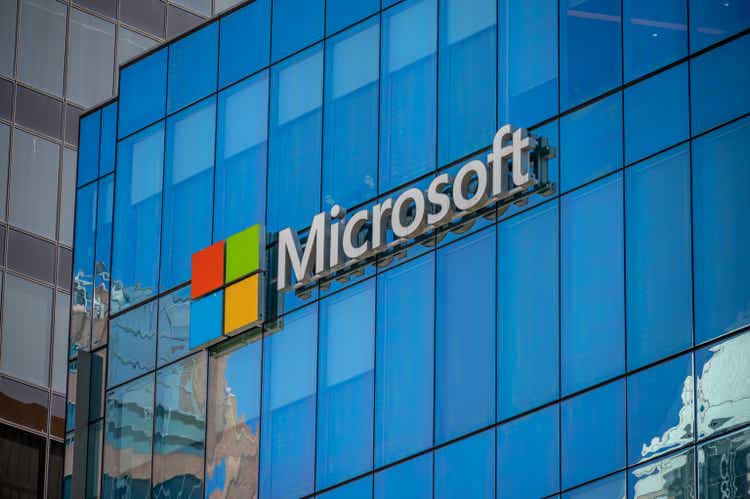Summary:
- Microsoft Corporation is set to announce 14th consecutive quarterly dividend increase.
- While Microsoft has enormous room to even double the dividend, future growth prospects are dependent on capital investments.
- I predict a 10% dividend increase in September.
- Do not underestimate the power of compounding even if the starting yield is low.
jewhyte
Microsoft Corporation (NASDAQ:MSFT) has just declared its quarterly dividend of 68 cents as Seeking Alpha has reported here. Why is this worthy of an article you may ask. Because this marks the 4th consecutive quarter that Microsoft has paid the same dividend, which means the company is likely to announce its annual dividend increase when it declares its next dividend in September. Who cares about Microsoft’s dividend you ask? Read on.
Before predicting the new quarterly dividend, let’s have a quick look at Microsoft’s dividend growth history.
Microsoft’s Dividend History
- Microsoft first paid dividends in 2003 when it announced an annual dividend of 16 cents per share, while announcing a 2:1 stock split as well.
- Flushing with cash, the company then announced a special dividend of $3 per share.
- The company then increased its quarterly dividend by a cent or two each year till 2008, before freezing (meaning paid the same dividend) the dividend in 2009.
- Since 2010, the company has announced 13 consecutive dividend increases in the month of September as the quarterly dividend has gone up from 13 cents per share to 68 cents per share in this time period.
- On an annual basis, Microsoft’s dividend growth streak stands at 18 while the company has been increasing the dividend at a set schedule for 13 consecutive years. So, if history is any indication, September 2023 should mark the 14th consecutive year where the dividend announced for the 4th quarter of the calendar year has gone up YoY.
MSFT DG (Chart compiled by author with Seeking Alpha data)
Dividend Coverage
Now, all the above is in the rear view mirror. To estimate Microsoft’s 2023 dividend increase, let us look at how much the company can afford.
- Total shares outstanding: 7.43 billion, which has gone down by 3% over the last 5 years.
- Current quarterly dividend per share: 68 cents.
- Quarterly Free Cash Flow (“FCF”) required to cover dividends: $5.05 billion, which is 7.43 billion shares times 68 cents dividend per share.
- Average FCF over the last five years: $12.59 billion
- Payout using five-year FCF: 40% ($5.05 billion divided by $12.59 billion).
- Average FCF over TTM: $14.35 billion
- Payout using TTM FCF: 35% ($5.05 billion divided by $14.35 billion).
- Using forward EPS of $9.65, Microsoft has a payout ratio of 28% based on current annual dividend of $2.72.
I am little surprised at the payout ratio based on FCF as I fully expected that to be less than 30% as well like the EPS based payout ratio. Nonetheless, Microsoft’s dividend coverage is ridiculously strong.
New Dividend Forecast
So, where does that leave us with the new dividend? Strong companies like Microsoft and Apple, Inc. (AAPL) can afford to pay a lot more but are more measured with their dividend increases.
MSFT DGR (Author)
It is not surprising that some investors are unhappy with the company’s “stingy” dividend. On the other hand, some believe the company is better equipped to reinvest its additional cash back into its business, thereby producing higher results than most individual investors can. I am of the latter opinion, especially given the hype and prospects around AI. The safest bet is to predict another 10% year, in line with the 5-year average, which should place the new quarterly dividend between 74 and 75 cents per share, pushing the yield close to 0.90%.
Perspective and Conclusion
I can hear readers groaning and/or laughing at that yield but do not underestimate the power of growing dividends even when the starting yield appears low, as long as the dividend growth remains strong (read compounding effect) and the dividend coverage looks good. Both these factors are in favor of Microsoft Corporation. Companies tend to go through cycles of growth, maturity, and decline. Microsoft is no exception as evidenced by its scorching growth till early 2000s, followed by a decade of nothing before it came back roaring with Satya Nadella and Azure as the torchbearers. While AI seems like the next catalyst, I won’t be surprised by a few years of low (if not no) capital returns as multiple compression cannot be ruled out even if the lofty expectations are met. At such times, the impact of a growing dividend will be more palpable even if the current yield happens to be low.
Finally, as of this writing, the stock has a forward multiple of nearly 35 and is beyond full valued, if not outright overvalued. The elephant in the room happens to be AI with its prospects and potential impact to the upside still largely unknown. I rate the stock a hold and will happily collect my dividends and look forward to a double digit increase in September.
Analyst’s Disclosure: I/we have a beneficial long position in the shares of AAPL, MSFT either through stock ownership, options, or other derivatives. I wrote this article myself, and it expresses my own opinions. I am not receiving compensation for it (other than from Seeking Alpha). I have no business relationship with any company whose stock is mentioned in this article.
Seeking Alpha’s Disclosure: Past performance is no guarantee of future results. No recommendation or advice is being given as to whether any investment is suitable for a particular investor. Any views or opinions expressed above may not reflect those of Seeking Alpha as a whole. Seeking Alpha is not a licensed securities dealer, broker or US investment adviser or investment bank. Our analysts are third party authors that include both professional investors and individual investors who may not be licensed or certified by any institute or regulatory body.
